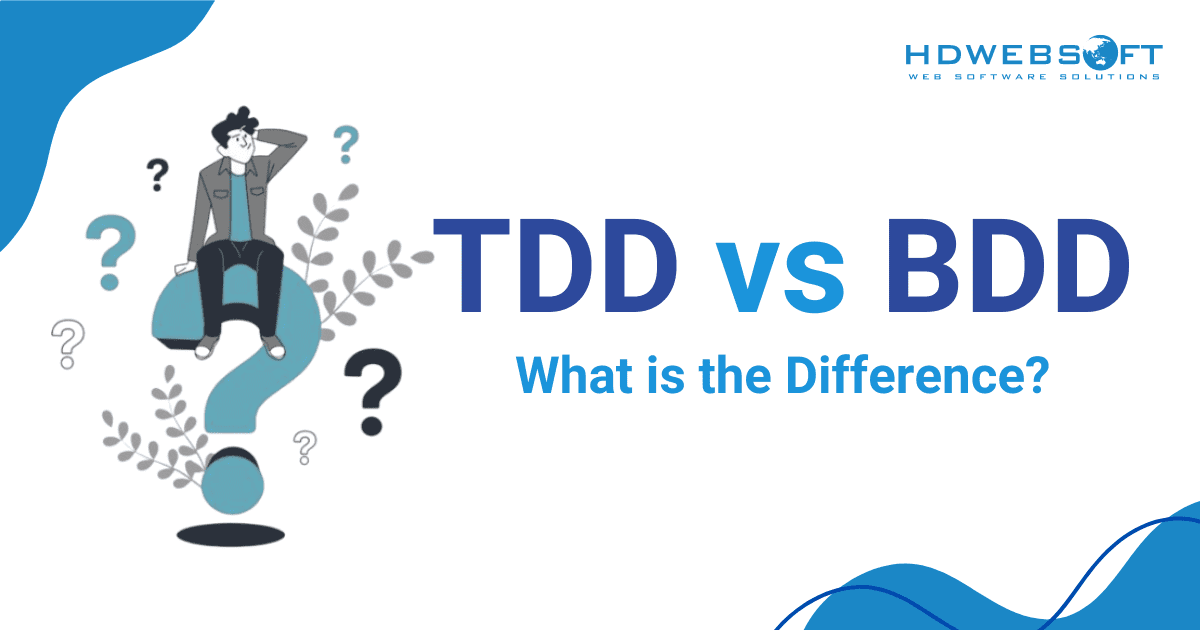
TDD vs BDD: What is the Difference?
Test-Driven Development (TDD) and Behavior-Driven Development (BDD) are both software development strategies in which automated tests play a vital role. While they both aim at improving software quality, they differ significantly in philosophy and application.
TDD typically involves writing a test that checks if the addition function works correctly and then writing the code to make the test pass. In 2023, TDD adoption rates have increased to 67% as more development teams recognized its benefits in reducing bugs and improving code maintainability.
On the other hand, BDD would involve writing a scenario that describes how a user would add two numbers and finally implementing the code to make the scenario pass. Though there are challenges arise in the implementation process, BDD adoption rates have also been on the rise as the BDD testing tool market share is expected to reach more than 30 million by 2029, reflecting the demand for this methodology.
In this blog, we will discuss the definitions of TDD and BDD and their processes. Moreover, we will underscore the distinctions between TDD testing and BDD testing and the aspects to consider when choosing between the two.
What is Test-Driven Development (TDD)?
Test-driven development is a testing process in which developers write the test before actually writing the code. The test results provide insight into how to improve the code. Its primary goal is to make the code simple and accurate. and bug-free.
So, how do we do TDD testing? Let’s explore its process.
How to do TDD?
TDD is not a one-time event but a continuous and iterative process. After every test, the aim is to improve the code gradually. This iterative approach empowers developers, giving them control over the code’s evolution and ensuring that it meets the desired functionality.
Write a Test
Developers begin by writing a test defining the desired behavior or functionality of the code they write. These tests are written using a programming language or leverage some automation testing tool with low-code features for faster test authoring and execution. They are often referred to as unit tests and are written using testing frameworks like JUnit and NUnit, which use programming languages such as Java and .NET.
Execute one specific test
The next step is to run one specific test. The fundamentals behind TDD testing are that developers run a test and observe if it fails. Since no code has been written yet, the test should fail as expected. There are four main reasons why this step is necessary:
- If the test fails, it confirms that the feature you want to code is being checked for behavior. It is a piece of positive evidence that this test is trustworthy.
- This test, along with future tests, will guide development activities. By making them goals to strive toward, developers can focus on meeting the requirements and specifications outlined in the test plan.
- Running tests on undeveloped code is a good way to ensure that the testing infrastructure, frameworks, and environment are properly set up.
- As the cycle repeats, it provides developers with rapid feedback on the code’s accuracy. It enables them to identify misconceptions early on and reduce the possibility of introducing problems later on.
In other words, in TDD, a failed test is a good test.
Write the Code
With the failing test in place, developers proceed to write the minimum amount of code necessary to make the test pass. At this stage, the goal is not to create complete solutions. As mentioned above, the reason behind TDD is to use the test result to guide development, not vice versa. Developers should only optimize their code after receiving test inputs.
Refactor
At this stage, developers run all tests, including the one they just wrote, to confirm the new code is working properly and it doesn’t break any existing functionality. After the test passes, developers refactor the code to improve its design, readability, and performance while ensuring that all tests continue to pass.
After that, the Fail-Pass-Refactor cycle begins again. This is called the Red-Green-Refactor cycle of TDD.
What is Behavior-Driven Development (BDD)?
Behavior-driven development (BDD) is an extension of TDD that places a strong emphasis on understanding the system’s behavior from the end-user’s perspective. BDD testing shifts the focus from testing to specifying the desired behavior of the system through examples. By using simple language, BDD provides numerous benefits in the software testing process, ensuring that the end user’s needs and expectations are at the forefront of the development process.
The main thing to know about BDD testing is that it is meant to eliminate issues that might be caused by TDD. In contrast to TDD, BDD promotes creating behaviors and requirements and then using them as guidelines for test automation. Behavior and requirements might seem awfully similar to tests, but the difference is very subtle and important.
We have discovered the TDD testing cycle in the section above. The next questions are: how do we do BDD testing, and how is it relevant to the TDD testing process?
How to do BDD?
The BDD testing process typically involves two main steps:
Write Scenarios Using Gherkin Syntax
In BDD testing, scenarios are written in a human-readable format using Gherkin syntax. Gherkin is a business-readable, domain-specific language that allows you to describe software’s behavior without detailing how that behavior is implemented. This syntax uses keywords like Given, When, and Then to describe the system’s behavior. These scenarios serve as executable specifications that drive the development process.
Implement TDD
Once the scenarios are written, developers implement the corresponding functionality using the TDD approach. They write failing unit tests based on the scenarios, write the code to make the tests pass, and refactor as needed. This integration of BDD and TDD allows for a comprehensive approach to software development and testing.
What is the difference between TDD and BDD?
While TDD is centered around the developer’s perspective and the detailed design of the code, BDD is more abstract and focuses on the system’s behavior from the user’s standpoint. Here are some critical differences:
| Aspects | Test-driven development (TDD) | Behavior-driven development (BDD) |
| Focus and perspective | Implementation of code functionality through a test-first approach | Collaboration and shared understanding of system behavior from users’ perspective |
| Language and readability | Test cases are written with programming-centric language | Scenarios are written in Gherkin format, easily understood by both technical and non-technical members |
| Collaboration and communication | Collaboration between developers and testers | Collaboration among developers, testers, and business |
| Abstraction level | Focuses on low-level unit tests that confirm how individual code units behave | Focuses on higher-level tests that simulate user interactions or scenarios |
| Test organization | Tests are organized based on code structure and organizational or modular approach | Scenarios are organized around desired behavior, typically grouped by specific features or functionalities |
| Purpose | Ensures code correctness through automated tests | Promotes communication, shared understanding, and system behavior validation |
| Development workflow | Tests are written before developing code | Scenarios are defined collaboratively before implementing the code. Can implement TDD within BDD |
| Test scope | Narrow scope, typically focusing on individual code units | Broad scope, covering multiple units of code working together |
| Test case style | Technical and implementation-centric | User-focused and behavior-centric |
| Instant improvement and feedback | Constantly improves code through test failures | Improves scenarios and behavior through collaboration and feedback |
The choice between TDD and BDD
When deciding between TDD and BDD for testing, it’s essential to consider the specific needs and preferences of your development team and project requirements. Let’s take a look at several key aspects to consider:
Test-Driven Development (TDD):
- Focus on Code: TDD testing strongly emphasizes testing the internal logic and functionality of the codebase.
- Granular Testing: Developers write unit tests to validate individual components or functions, ensuring that each part of the code behaves as expected.
- Developer-Centric: TDD is well-suited for developers who prefer to focus on writing code and testing its functionality in isolation.
- Speed of Execution: Since TDD tests are typically written and executed at the unit level, they tend to run faster than BDD tests, making them ideal for rapid iteration and feedback cycles.
- Technical Expertise: TDD testing requires a solid understanding of programming languages and testing frameworks, making it more suitable for technical teams with strong coding skills.
Behavior-Driven Development (BDD):
- Focus on Behavior: BDD shifts the focus from testing individual code components to specifying the behavior of the system from the end-user’s perspective.
- Collaborative Approach: BDD testing encourages collaboration between developers, testers, and business stakeholders by providing a common language for discussing requirements and specifications.
- Executable Specifications: BDD scenarios written in Gherkin syntax serve as executable specifications that drive the development process, ensuring that the software meets the desired behavior.
- User-Centric Testing: By focusing on user behavior and interactions, BDD helps ensure that the software delivers value to end-users and meets their expectations.
- Accessibility: BDD testing scenarios written in plain language are more accessible to non-technical stakeholders, making them valuable for communicating requirements and expectations across teams.
Dive deep into our Software Testing Service
In Summary
TDD testing is a robust approach for developers looking to create maintainable, bug-free code. It emphasizes writing tests before the code, ensuring that each piece of code is tested and the design is clean. In contrast, BDD is excellent for projects where the user’s experience and the system’s behavior are paramount, and collaboration between technical and non-technical stakeholders is needed.
Choosing between TDD and BDD—or combining elements of both—will depend on your project requirements, team composition, and end goals. The right approach helps your team deliver quality software that meets or exceeds user expectations.











